
Hawkhurst is village and civil parish in the borough of Tunbridge Wells in Kent, England. The village is located close to the border with East Sussex, around 12 miles (19 km) south-east of Royal Tunbridge Wells and within the High Weald Area of Outstanding Natural Beauty.
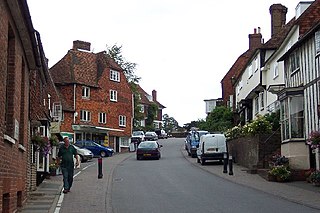
Goudhurst is a village and civil parish in the borough of Tunbridge Wells in Kent, England. It lies in the Weald, around 12 miles (19 km) south of Maidstone, on the crossroads of the A262 and B2079.
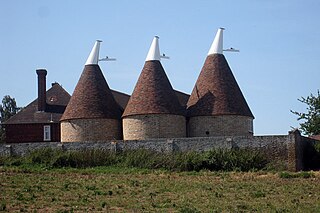
Lynsted is a village in Lynsted with Kingsdown civil parish in the Swale borough of Kent, England. The village is situated south of the A2 road between Faversham and Sittingbourne and the nearest M2 junction is Faversham three miles east. Lynsted is in many respects an archetypal old English village with church, churchyard with an ancient yew, pub and a duck pond. The village is locally referred to as Lovely, Lovely Lynsted and various songs have been written about it.

St Nicholas Church in Thames Ditton, Surrey, England, is a Grade I listed Anglican parish church that has parts that date back to the 12th century.
The Hawkhurst Gang was a notorious criminal organisation involved in smuggling throughout southeast England from 1735 until 1749. One of the more infamous gangs of the early 18th century, they extended their influence from Hawkhurst, their base in Kent, along the South coast, to Dorset, where they successfully raided the customs house at Poole. After they were defeated in a battle with the Goudhurst militia in 1747, two of their leaders, Arthur Gray and Thomas Kingsmill, were executed in 1748 and 1749.
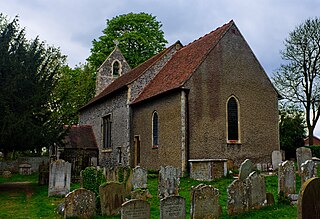
Old St Mary's Church, officially known as The Blessed Virgin Mary Church, is a grade II* listed Anglican church in Upper Walmer, Kent.
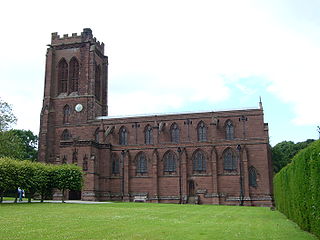
St Mary's Church is in the village of Eccleston, Cheshire, England, on the estate of the Duke of Westminster south of Chester. The church is recorded in the National Heritage List for England as a designated Grade I listed building. It is an active Anglican parish church in the diocese of Chester, the archdeaconry of Chester and the deanery of Chester. Its benefice is combined with that of St Mary, Pulford. The Dukes of Westminster are buried in the adjacent Old Churchyard.

St Peter's Church is in Chapel Street, Congleton, Cheshire, England. It is recorded in the National Heritage List for England as a designated Grade I listed building. It is an active Anglican parish church in the Diocese of Chester, the archdeaconry of Macclesfield and the deanery of Congleton. Its benefice is combined with those of St Stephen, Congleton, St John the Evangelist, Buglawton, and Holy Trinity, Mossley. Alec Clifton-Taylor includes it in his list of 'best' English parish churches. The Church Buildings Council included St Peter's in its group of 300 Major Parish Churches following research produced in 2016. [Pursell 2016]
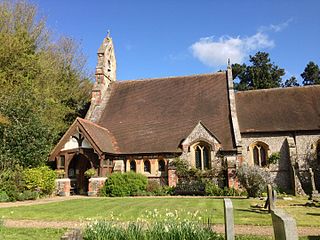
St Margaret's Church is an Anglican parish church in the village of Halstead and the Sevenoaks deanery, although the church also serves the village of Badgers Mount. St Katharine's and St Margaret's came together in 1983 as a United Benefice under one parish priest. The pattern of services reflects the fact that it is two parishes working closely together.

St Mary's Church is the redundant Church of England parish church of the village of Redgrave, Suffolk, England. It is a Grade I listed building. and is under the care of the Churches Conservation Trust. The church is on a rise about 3⁄4 mile (1 km) east of the village.

St Peter and St Paul's Church is in Gisburn Road, Bolton-by-Bowland, Lancashire, England. It is an active Anglican parish church in the deanery of Whalley, the archdeaconry of Blackburn, and the Diocese of Blackburn. Its benefice is united with that of St Ambrose, Grindleton. The church is recorded in the National Heritage List for England as a designated Grade I listed building.
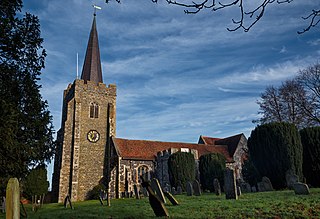
St Mary's Church, Wingham, is an Anglican parish church in Wingham, Kent. It is recorded in the National Heritage List for England as a designated Grade I listed building.

St Mary's Watford is a Church of England church in Watford, Hertfordshire, in England. It is an active church situated in the town centre on Watford High Street, approximately 25 kilometres (16 mi) outside London. St Mary's is the parish church of Watford and is part of the Anglican Diocese of St Albans. Thought to be at least 800 years old, the church contains burials of a number of local nobility and some noteworthy monumental sculpture of the Elizabethan and Jacobean eras.

St Andrew and St Mary's Church is a Grade I listed Church of England parish church dedicated to Saint Andrew and Saint Mary, in the parish of Easton and the village of Stoke Rochford, Lincolnshire, England. The church is 5 miles (8 km) south from Grantham, and at the western side of the Lincolnshire Vales in South Kesteven.

St John the Baptist Church at Penshurst, Kent is a Grade I listed Anglican parish church in the Diocese of Rochester in England. Those buried or commemorated here include Knights, Earls, Viscounts, a Viceroy of India, a Governor-General of Australia, a Private Secretary to two Kings, two Field Marshals and two winners of the Victoria Cross. Through its courtiers, soldiers, statesmen, politicians or priests whose lives appear on memorials or through its changing architecture, brasses, carvings, effigies and windows, the church helps tell a country's story through the eyes of single village.

St Nicholas' Church is an Anglican parish church in Stevenage, a town in Hertfordshire, England.

Thomas Kingsmill was one of the leaders of the notorious Hawkhurst Gang of smugglers that operated, from its base in Kent, along the South Coast of England from 1735 until 1749. One of the more infamous gangs of the early 18th century, they extended their influence from Hawkhurst, their base in Kent, along the South coast, to Dorset.

St Mary and St Benedict is the Church of England parish church for the village of Buckland Brewer near Bideford in North Devon. It is part of the benefice of the Hartland Coast Team Ministry. This falls within Hartland Deanery, in the Archdeaconry of Barnstaple in the Diocese of Exeter. Begun in the 14th-century with 15th-century additions and retaining several architectural features from the first church of about 1100, the building was much restored in the 19th-century and has been a Grade II* listed building on the Register of Historic England since 1958.

Christ Church is a Church of England parish church in Kilndown, Kent, England. It was built in 1839 under the commission of William Beresford, 1st Viscount Beresford, and was substantially reordered in the early 1840s in accordance with the principles of the Cambridge Camden Society. Its layout and rich interior decoration, contributed by a range of major architects of the era, made it "a showcase" of the influential Society's ideas: John Betjeman described the church as "a museum of the Camden Society". It was severely damaged by bombing during the Second World War, but has been restored. It is a Grade I listed building.
























